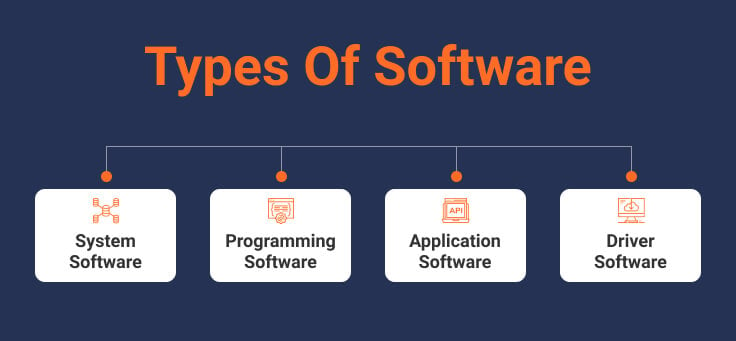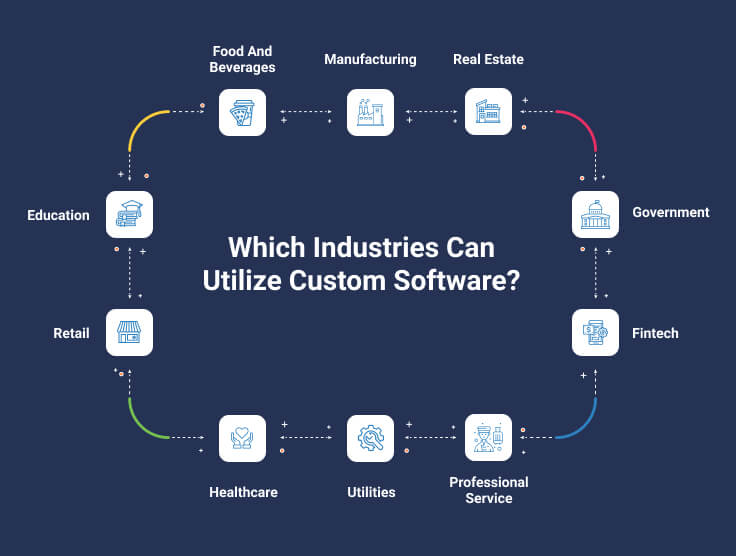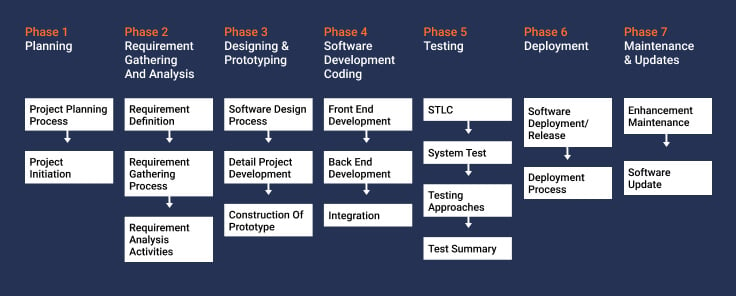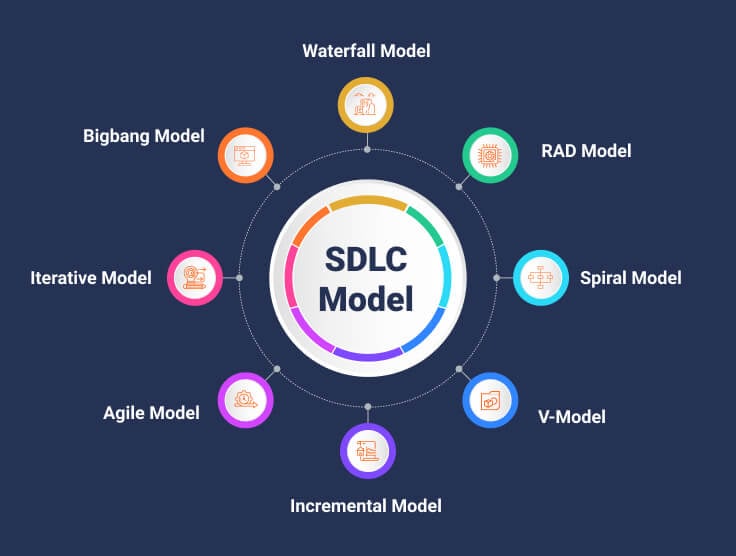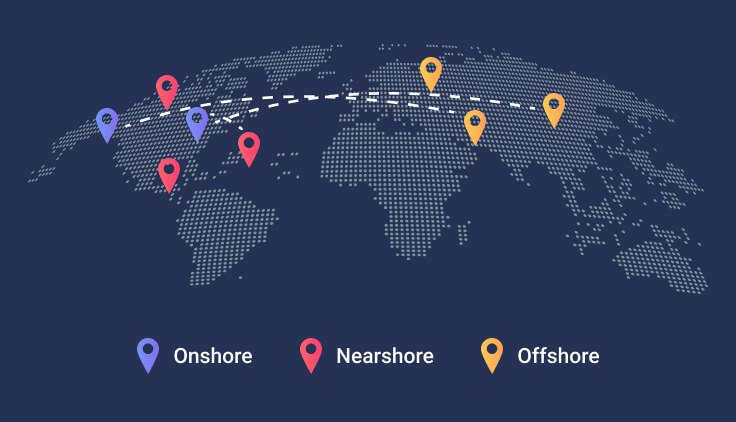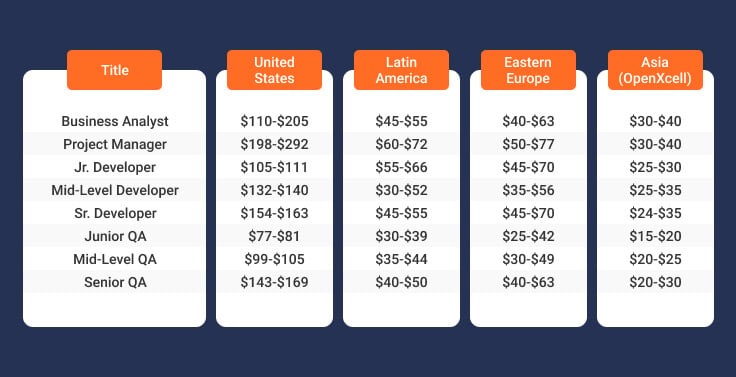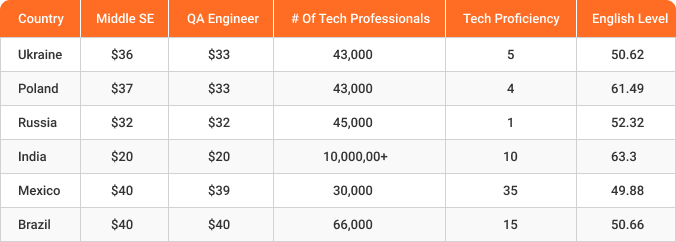Software Development - The Complete Guide for 2024
GET A QUOTE NOW 100% Confidential and Secure
- Software Development - Introduction
- What is Software Development?
- Types of Software Development
- Importance of Software Development
- Who can benefit from Software Development?
- Software Development Life Cycle (SDLC)
- SDLC Models & Methodologies
- Waterfall Model
- Agile Methodology
- DevOps
- RAD (Rapid Application Development)
- Scrum Methodology
- Spiral Model
- Lean Methodology
- Kanban Methodology
- Incremental Model
- Prototype Model
- Software Outsourcing
Software Development - Introduction
Software development penetrates all the significant aspects of our life in this digital age. Individuals, startups, and big enterprises rely upon different software to carry out their daily tasks. There is no doubt that enterprise software development has the highest growth rate compared to every other tech industry. Besides, Software development is projected to outgrow in 2023. According to a report from Statista, Global spending on enterprise software development will touch 755bn USD in 2023. Yes! That’s Billions with ‘B.’
Key software development statistics to know:
- It is expected to reach $1039 billion by 2027. That’s a CAGR of $25.54% from 2020 to 2027
- Nearly 1 in every 4 companies outsources their software development projects.
- The average software development project takes 4.5 months to build and costs $36,000.
- By 2024, there are expected to be 28.7 million software engineers in the world.
- The number of software developers is anticipated to grow by 22% by 2029.
These statistics and reports are helpful to someone who wishes to develop software. But before diving into further discussion, let us understand the basics of the software.
(I) What is Software? What are its Types?
Software is something that tells a computer what to do. In technical terms, “Software” is a set of instructions, data, or programs to operate computers and execute specific tasks. It is precisely the opposite of hardware, which describes the physical aspect of the computer system. Software is a general term that describes applications, scripts, and programs that run on a device.
Some common examples of the software include Google Chrome, Gmail, Adobe Reader, Microsoft Word, Powerpoint, and many other similar programs that we often use in our daily lives.
Types of Software
Among the various categories, there are generally four main types of software: They are:
1. Application Software
Application software is the most common type of computer software. It can be defined as an end-user program that helps you perform tasks and achieve desired outcomes. Here, the end-user is the person who is using the product, program, or software. Application software can be self-contained, or it can be a group of programs that run the software for the user.
Some common examples of application software are internet browsers like Chrome, CRM tools like Hubspot, Photo editing apps like Adobe Photoshop or Lightroom, or word processing software like Microsoft Word.
Application software is installed on a mobile device or a computer of users based upon their needs. As this is the most common type of software, there are many options available in the market to choose from.
Learn more about → Application Software
2. System Software
System software helps the computer or mobile device, the application, and the users to work together seamlessly. As a result, the System software is essential for running any application software or the whole computer system. It manages the operations of hardware and software and provides the platform for all types of software.
The best examples of System Software are OS like Apple’s IOS and Microsoft Windows. Some other examples include Firmware and System Utilities. This software always runs in the background and is never seen directly. People only remember it at the time of the update.
Learn more about → System Software
3. Programming Software
Programming software is the software that computer programmers and software developers use to write codes. Programming software enables developers to write, develop, test, and debug other software programs. They take programming languages like C, C++, Javascript, Python, and Java and translate them into machine language.
Examples of Programming software are assembler, compiler, debugger, and interpreter.
Learn more about → Programming Software
4. Driver Software
Driver software, also known as device drivers, is considered to be a type of system software. Driver software operates and controls the peripherals and devices that are attached to a computer. Drivers make it possible for the devices plugged into the computer to perform necessary tasks. Each device needs at least one driver to function.
Examples include non-standard hardware like game controllers and standard hardware like USB storage drives, Printers, and Keyboards.
Apart from these major types of software, there are five other subcategories. These subcategories are :
- Freeware
- Shareware
- Open Source Software
- Close Source Software
- Utility Software
(II) What is Software Development?
Software Development is a set of activities dedicated to creating, designing, programming, documenting, testing, and maintaining applications, frameworks, and other software components. Software development is the process of writing and maintaining the source code at a broader level. Hence, software development may include research, new development, prototyping, modifications, software engineering, maintenance, or any other software product or application activities.
Software development is done for the various purpose, but the three most common reasons are :
- To meet the specific requirements of a particular client or business, or organization. (Custom software)
- To meet the needs of some specific set of users. (Open Source or Commercial Software)
- To meet the requirements of personal use. (Personalized Software)
Software development is primarily done by software developers, programmers, and software engineers. Their roles highly interact and overlap, and the dynamics between them vary greatly across the development departments.
Software developers are closely involved with the specific area of writing the code. Besides, they drive the overall Software Development Life Cycle – SDLC. It includes working with cross-functional teams, Transforming requirements into features, Managing development processes and teams, and Conducting software testing and maintenance.
Programmers or Coders write the program’s code to perform specific tasks like merging databases, routing communications, displaying texts, etc. Programmers usually get instructions from Software Developers and Software Engineers. They use programming languages like Javascript, Java, and C++ to carry out those instructions.
Software Engineers apply their knowledge and engineering principles to software and products to solve problems. They use modeling languages, tools, and Software development frameworks to develop solutions. They Adhere to scientific methods and make sure their solution works in the real world.
Software development is a rapidly growing field with high demand and the competitive job market makes it an attractive industry to be a part of. As per the US Bureau of Labor Statistics, the employment of software developers is expected to rise at a minimum of 25% from 2021 to 2031. This growth is faster than the average of all occupations. In some reports, this criteria can even touch 30%.
With such high demand for software developers, there is a high diversity of work in various types of Software development. Here are the major types of software development.
Types of Software Development
Software development is the core activity of the IT industry and is divided into 10 main types. These types are as follows.
1. Application Development
Application Development is developing a computer program or a set of programs to assist users, businesses, or organizations in using functionalities. These are the standard applications that perform traditional duties on operating systems.
Application Development languages: Java, C/C++, C#, Python, and much more.
2. Web Development
Web Development is the process of developing a website for the internet. The web Development process can range from developing a single static page to complex web applications.
Web development involves the development of thousands of interconnected web pages that only a web developer can organize. Web Development Company is booming, thanks to the latest Web Technologies and APIs that let plugins be used in a website.
Web Development Technologies: HTML, Javascript, PHP, Python, Ruby and Rails, ASP.NET, Django, C/C++, and much more.
Learn more about → Web Development
3. Mobile Development
Mobile Development, also known as App Development or Mobile App Development, could be defined as creating applications that run on mobile devices such as iPhones and Android devices. Recently these apps have been successful in running on Windows 10 platform.
Mobile Development Technologies: Android, Swift, Objective C, HTML5, Java, C#, Javascript, and much more.
Learn more about → Mobile App Development
4. Data Science
Large chunks of data are not much valuable until you know what to do with it. That’s where the role of Data scientists comes into play. They find value from the data.
Scientific applications are developed based on the mined data. As machines need large amounts of data to learn and make their own decisions, Data Scientists ensure that the data is presented in the correct form to be used in AI applications.
Data Science Technologies: MATLAB, Python, C/C++, and much more.
Learn more about → Data Science
5. Software Tools Development
Consumers do not use this type of Software, but it is crucial for the software development Industry. It builds tools for other software developers to test and code. Apart from development and testing, this software help developers to maintain the industry standards in their development.
Tools Development Technologies: Java, Python, C++.
6. API Development
API Development or Application Programming Interface is the program that developers build that acts as a puzzle piece across different operating systems. They allow any 3rd party developer to interact with the tools or functions that API relates with.
APIs are written for specific platforms, and each API has the programming language of the platform or device for which it is particularly designed.
Learn more about → API Development
7. Embedded Systems Development
Embedded Systems Development is specialized for the specific system that your machine or device runs on. This type of software development deals with coding skills needed for embedded systems like Arduinos and Raspberry Pi.
Embedded System Technologies: Embedded C, Assembler, Python, Arduino, and Java.
8. Security Software Development
White hat hackers and cybersecurity experts work for the betterment of companies and their critical data. The cybersecurity team develops software to keep the organization’s important assets safe from theft, viruses, and malicious attacks.
Here the programming language relevant to the system that needs to be tested must be known.
9. Cloud Computing
Cloud computing services use a network of remote servers to store data and access services instead of local servers or personal devices. The developers involved in cloud computing software development develop the software to power cloud storage applications. Typical examples of cloud computing software are Amazon Web Services (AWS), Onedrive Storage, and Github.
Cloud computing Technologies: Java, XML, R, Erlang, Google’s Go, Clojure, and much more.
Learn more about → Cloud Computing
10. Backend Development or Database Development
Back-end Development, also known as Database Development, goes on behind the scenes in the system. The back end or the server side of the website is where the data is stored.
Database management is the prime aspect of back-end development. It is also the backbone for organizations that hold large amounts of data. Backend developers manage and organize a large amount of data in the backend development process.
Backend Development Technologies: Python, Java, C, C++, MySQL, dBase, and Oracle for the database.
Apart from these 10 types of software development, Custom Software Development and Commercial Software Development have significant differences. Custom Software Development is the process of designing, creating, deploying, and maintaining software that meets the unique requirements of a set of users, functions, organizations, or individuals. In contrast, commercial off-the-shelf software (COTS) is designed and developed for a broader range of audiences, allowing it to be packaged and commercially marketed, and distributed.
However some types of software exceed others in terms of use and popularity in the market. Each of these developments has its importance. Let’s take a look at why software development is important in today’s generation.
Importance of Software Development
Software Development is important because it helps businesses to differentiate from one another and be more competitive. It can make businesses highly innovative, improve customer experience, and feature-rich products, market faster and make business operations more efficient, safe and productive.
Software Development is also important because it is prevalent and used in every other task. In the era of digitalization, it is the software that stores, integrates, and centralizes the data so we can access it. Also, Software developments hold an account for the security and protection of your data.
There are lots of advantages and enhancements that we can gain through software development. Among them, here are the top 5 reasons why software development is important for your business.
1. Promote your business
Software development takes your business to the next level. It helps to promote your business and spread awareness about your brand. It lets your brand be visible throughout the world.
2. Improve sales and services
Having a digital presence of your business through software development can skyrocket your sales. It allows you to expand your business worldwide. Besides, it is essential to know what your customers think about your brand, products, and services. For this, you must have an online platform so your customers can easily reach out to you.
3. Direct communication
Software development is the only way that lets you communicate directly with your end customers. It is also the fastest and easiest way to spread your brand awareness.
4. Increase customer engagement and satisfaction
Online marketing done with the help of marketing software helps in increasing customer loyalty and delivers better customer engagement. Businesses need to have a good marketing strategy to provide better customer satisfaction and retain their customers.
5. Helps in marketing your business
Software development is the best and most efficient way to apply on-the-go marketing without spending extra time, money, and effort. You can reach customers at any point in the world.
Who can benefit from Software Development?
The work of software development isn’t confined to software developers, programmers, or development teams. Professionals such as scientists, hardware makers, device fabricators, testers, and many other people can code even though they are not software developers.
As per the Statista’s latest reports, Information and Communication Technology (ICT) is expected to reach a total spending of 5.8 trillion US Dollars by 2023. The Non-ICT spending is also expected to commensurate with the increased digital requirements and might reach upto 4.5 trillion US Dollars.
In this modern age, software development is imperative for any business, irrespective of its industry. It does not matter which sector your business belongs to or how big or small it is. It can benefit from software development in one way or another.
Software development companies focus on creating software solutions specifically designed to meet their client’s requirements. They cater to retail, manufacturing, healthcare, hospitality, Education or edTech, finance or FinTech, catering, pharmaceutical, and every other industry out there. Thus, we can say that there is no such industry that can not benefit from software development.
Now that we know about software development and its importance, let’s understand the software development process, also known as Software Development Life Cycle (SDLC). Everything you need to do is follow this step-by-step Software Development Life Cycle to build your software.
(III) What is Software Development Life Cycle?
Software Development Life Cycle (SDLC) is a standard process used by software development companies to design, develop and test high-quality software. The main aim of SDLC is to produce high-quality software that meets business requirements and customer expectations and reaches completion within the time and budget estimates.
SDLC is the abbreviation used for the Software Development Life Cycle. It is also known as Software Development Process. SDLC life cycle is a framework of defined tasks performed at each step of the software development process.
The international standard in software engineering for the software life cycle process is ISO/IEC/IEEE 12207. These standards and life cycles hold a lot of importance in software development. Let us know the reason behind it.
Importance of Software Development Life Cycle
- It acts as a guide to project management.
- It helps in determining the clear end goals.
- It helps in meeting the client’s requirements.
- It helps in evaluating, scheduling, and eliminating deliverables.
- It acts as a framework for a standard set of activities.
- It ensures accurate and on-time delivery to the client.
- It ensures complete testing of the project.
- It ensures optimal control and minimizes the risks of the project.
- It provides flexibility to the project.
- It keeps track of the project with high accuracy.
To understand Software Development Life Cycle (SDLC) in a better way, let us deep dive into the SDLC phases.
Software Development Life Cycle (SDLC) Phases
A standard Software Development Life Cycle consists of 7 SDLC phases.
Let us understand each phase of SDLC in detail.
1. Planning
Planning is the most important and fundamental stage of SDLC. The most senior team members perform it with the help and inputs of customers, the sales and marketing department, and domain experts of the industry. This information is used to conduct feasibility studies in economic, legal, operational, technical, and schedule areas.
Planning related to Quality Assurance (QA) and risk identification of the project is also done in this phase. This phase aims to determine the approach to be followed to implement the project with minimum risks.
Effective planning consists of a good project planning process and the Latest as well as effective planning software. To better understand the planning phase, let’s take a look at the software development project planning process.
Project Planning Process
The project planning process consists of 8 main steps. By following these project planning steps, you can clarify your needs, work out your approach and develop an action plan to move forward. These steps are :
- Outline the Business Case
- Define Project Scope
- Set Goals and Objectives
- Outline Deliverables
- Create a Project Schedule
- Assign the task to your team
- Assess Risk
- Report your progress
Learn more about → Project planning
Project Planning Software
Project Planning Software is a tool to facilitate project management processes such as schedule development, team management, resource allocation, cost estimation, and risk monitoring.
Some of the best project planning tools and software are :
2. Requirement Gathering and Analysis
This is the second phase of the Software Development Life Cycle (SDLC). This phase clearly illustrates the entire project’s scope with the related issues, risks, and opportunities.
Requirement Gathering
Requirement Gathering is a process of researching and documenting the project requirements. Requirement gathering plays a vital role in the overall success of the project.
Requirement Gathering Process
The requirement-gathering process consists of five major steps. These steps are:
- Assigning Roles
- Interview Stakeholders
- Gathering & Documentation
- List Expectations and Requirements
- Monitor the Process and Feedback
Requirement Gathering Tools
Requirement Gathering Tools are simply the resources you can use to complete the requirement-gathering process faster and easier.
Here are the top requirements-gathering tools :
- Jama Software
- Modern Requirements
- Visure Requirements
- Orcanos
- IBM Engineering Requirement Management DOORS Next
Requirement Analysis
Requirement Analysis or Requirement Engineering defines user expectations for developing new software or modifying the existing one.
Requirement Analysis Activities
Requirement Analysis includes four types of activities. These activities are :
- ELICITING REQUIREMENTS: It is the task of communicating with the customers and users to determine their actual requirements.
- ANALYZING REQUIREMENT: Verifying the requirements are unclear, ambiguous, contradictory, or incomplete, and then resolving the occurring issues.
- REQUIREMENT MODELING: Requirements are documented in different forms like natural language documents, use case diagrams, process specifications, or user stories.
- REVIEW AND RETROSPECTIVE: Team members review iterations and finalize improvements to move forward.
Requirement Analysis Techniques
Requirement Analysis Techniques can be classified under two categories. These categories are :
BUSINESS REQUIREMENTS:
Business Requirements relate to a business objective, goals, and vision. They provide the scope of business needs and problems that should be addressed.
Techniques for identifying business requirements :
- BPMN – Gap Analysis
- ArchiMate – Gap Analysis
- BPMN – As-is and To-be Analysis
- Business Motivation Model
- Customer Journey Mapping
SOFTWARE REQUIREMENTS:
Software requirements break down the steps that are needed to meet the business requirements. While business requirements state the ‘Why’ of a project, software requirements focus on the ‘What.’
Techniques for identifying software requirements :
- Data Flow Diagrams (DFD)
- Use Case Diagrams
- User Stories
At the end of this phase, a complete SRS document is made, consisting of overall project requirements.
Learn more about → Requirement Analysis
3. Designing and Prototyping
This SDLC phase starts by turning the Software Requirement Specifications (SRS) document into a design plan called design specification.
This phase is crucial and involves stakeholders’ input into this document. Then, an overall system architecture is defined, which serves as an input for the next SDLC phase.
Lets us take a deeper look at software design in the SDLC life cycle.
Read more about → SDLC Design Phase
What is Software Design?
Software design is a process to transform user requirements, i.e., an SRS document into a suitable form, which helps the software developer in software coding and implementation. It is the first phase of SDLC, which moves from the problem domain to the solution domain.
Software Design Process
The Software Design process can be divided into three levels of design phases:
ARCHITECTURAL DESIGN:
Architecture Design is the highest level of the abstract version of the system. It also identifies the system as many components interacting with each other. At this level, the designers get a better idea of the proposed solution domain.
PRELIMINARY OR HIGH-LEVEL DESIGN:
Here, the problem is decomposed into a set of modules. The control relationship and the interface among the various modules are identified in this phase of SDLC. Structure charts and diagrams are used as representation techniques.
DETAILED DESIGN:
Detail design is taken into consideration after High-level design is completed. In detailed design, each module is examined to design the data structures and algorithms. This phase is more detailed about the module and its implementation.
Principles of Good Software Design
A remarkable user experience and customer satisfaction and loyalty are obtained as end results when the following software design principles are applied.
The principle of good software design are:
MODULARITY: Dividing a large software project into smaller modules or portions is known as Modularity.
COUPLING: Coupling is referred to as interdependence between software modules and how closely they are connected.
ABSTRACTION: Abstraction is hiding irrelevant information and shows only essential details to the user.
ANTICIPATION OF CHANGE: Building a software design that can accommodate and adjust according to changes.
SIMPLICITY: Good software design aims to simplify code, make it easy to use, and minimize setbacks.
SUFFICIENCY AND COMPLETENESS: A good software design ensures the software’s sufficiency and completeness and ensures that the software is adequate and fully built.
What is Prototyping?
Prototyping or software prototyping is creating an incomplete version of a software product or application being developed. We can say it is a working model of software with limited functionality.
Learn more about → Prototyping
Types of Software Prototyping
There are different types of prototyping used in the software development industry. The following are the major types of prototypes preferred by software developers in the software development process.
- Throwaway / Rapid Prototyping: Throwaway Prototyping is also called Rapid or Close Ended Prototyping. Minimum requirements analysis and fewer efforts are required in this type of prototyping. As soon as requirements are understood, this prototype is discarded, and the original software is developed with a better understanding of user requirements.
- Evolutionary Prototyping: Evolutionary Prototyping, also known as Breadboard Prototyping, is based on creating an actual functional prototype with minimum functionalities at the beginning of the software development process. When using Evolutionary Prototyping, only the well-understood requirements are added to the prototype.
- Incremental Prototyping: Incremental Prototyping refers to building multiple functional prototypes of various subsystems. Then, all the available prototypes are integrated to form a complete system. This method is beneficial to reduce the feedback time between the user and the software development team.
- Extreme Prototyping: Extreme Prototyping is used in Web Development, and it consists of three sequential phases. In the first phase, a basic prototype with all the existing pages is presented in HTML format. Then in the second phase, data processing is simulated using a prototype service layer. And in the third phase, the services are implemented and integrated with the final prototype.
Advantages of Prototyping
There are many advantages of using a prototype in software development. Some of the important ones are noted below.
- Reduced Time & Costs: When changes are detected later in the software development, it costs much to implement them. The early determination of what the user wants through prototyping can result in faster and less expensive software.
- Improved and Increased Users Involvement: The prototype allows the user to interact and provide feedback on it. The user knows and understands the problem domain better than the software developer or software development team. Prototype solves the misunderstanding through user involvement. Also, it helps the final product be developed to give more satisfaction to the user.
- Improve Product Quality: With the prototype, users can anticipate the needed changes and potential project hurdles, and potential end-result disasters. Strong prototyping can ensure improved product quality for years to come.
Disadvantages of Prototyping
No project development is perfect. Perhaps, using or misusing prototyping also has its disadvantages. The major ones are as follows:
- Insufficient Analysis: Focusing on a limited prototype can distract a software developer from properly analyzing the software project. It can lead to poorly engineered final products or incomplete specifications. This also causes end software products to be very hard to manage.
- User Confusion: Often, users, by mistakes or confusion, consider the prototype as a finished product. Also, they expect the prototype to function accurately as the end product, whereas that is not the intent of the software developer.
- Developer Misunderstanding of Users Objectives: For a successful software development project, it is important to have a software developer and user be on the same page and share the same project objectives. If the user requires all the features of a prototype to be included in the final software product, this can create team and mission conflicts.
- Excessive Development Time: The key property of a prototype is that it is supposed to be done quickly. If software developers lose sight of this fact, it can lead to complexities. In such cases, the user can be stuck in debate and hold up the software development team underlying the software development project.
- Expenses of Implementing Prototyping: The startup cost of building a dedicated development team focused on prototyping may be expensive. Besides, many software development companies have their software development methodologies in place, and changing them can mean retraining and retooling their software developers. This may add to the extra costs.
- Developer Attachment to prototype: Software developers can also become attached to the prototype as they have spent time and effort on it. This may create development issues like converting a limited prototype into a final software product.
4. Software Development / Coding
Once the design phase is over, the next phase in the Software Development Life Cycle (SDLC) is coding. This is the actual phase where software development is done. This SDLC phase is also known as implementation.
In this phase, software developers start to build the entire software product or application by writing code. Multiple programming languages are used to write code in the software development process.
In the coding and implementation phase, tasks are divided into smaller units or modules and assigned to developers. Few developers might write a small project, while a large project may need a complete software development team. Coding is the most extended phase of the Software Development Life Cycle.
Basically, the software development/coding phase is subdivided into two areas, Front End and Backend.
Read more about → SDLC Development Phase
Front End Development
Front End Development, also known as client-side development, is developing HTML, CSS, and Javascript for a website or Web Application that users can see and interact with directly. The web designer and web developer creating the user interface are called front-end developers.
The challenges associated with front-end development are that the tools and frameworks used to create a front-end application, website, or web application change constantly. So, front-end developers need to be aware of how the field is developing.
Learn more about → Front End Development
Front End Frameworks
Front End Frameworks are the pioneer blocks of the software development process. But there are various options to choose from when it comes to building web applications that rank higher on UI and UX. Here is the curated list of Top Front End Frameworks for web development in 2024.
- React: Being one of the simplest frameworks to learn, React was developed at Facebook to fix code maintainability issues. Reactjs is basically an open-source front-end javascript framework for building user Interfaces or UI components. React Official Website.
- Angular: Officially launched in the year 2016, Angular JS was developed by Google to bridge the gap between technology and conventional concepts. If you want to build mobile or web apps, Angular is the perfect framework for you. Besides, this front-end framework is also used to develop multi-page and progressive web apps. Due to this reason, companies like BMW, Blender, Xbox, Forbes, and others deploy applications with Angular. AngularJS Official Website.
- Vuejs: VueJS is a very simple and straightforward Front End Framework. VueJS is versatile and can do multitask. It can handle Web Applications, Mobile apps as well as Progressive Web Applications. Companies like Alibaba, 9gag, Xiaomi, and Reuters are some well-known users of this framework.
- jQuery: jQuery was introduced in 2006 and is one of the oldest front-end frameworks. is easy and simple to use. It also minimizes the need for writing lengthy JavaScript codes. The recent update in this framework enables front-end developers to build native mobile applications.
- Flutter: Flutter is a cross-platform and open-source UI software development kit created by Google. Compatibility, reload speed, and top-notch performance are the advantages of Flutter. Google Ads, Birch Finance, Cryptograph, Hookie, and Alibaba are well-known applications powered by Flutter.
Backend Development
Backend Development refers to server-side development, which primarily focuses on how the website works. Backend Development usually consists of three parts: a server, an application, and a database. Codes are written by backend developers that communicate with the server, database, and browser. Backend developers are also called programmers or web developers.
Learn more about → Backend Development
Backend Frameworks
Backend Frameworks are essential to application development across the globe. Finding the right backend framework is crucial for software developers to obtain optimal performance and scalability.
Here is the curated list of Top Backend Frameworks for 2024.
- Django: Django is a leading open-source backend framework based on the Python programming language. It is highly suitable for the development of feature-rich and sophisticated software products and applications. Django is considered to be one of the best backend development frameworks.
- Laravel: Laravel is an open-source PHP web-based framework for developing web applications that follow Model View Controller (MVC) architecture. Lavarel is rated as one of the best backend frameworks for software development. Laravel has MIT License and also has an open-source code repository on GitHub.
- Ruby on Rails: Ruby on Rails, also known as Rails, is a Ruby-based server-side framework. It is one of the best frameworks for web development. Ruby on Rails uses standards like XML and JSON for parsing and CSS, HTML and JavaScript for interfacing.
- ExpressJS: Express.js, also known as Express, is a Node, js-based open-source web application framework. It is widely used for building APIs and Web Applications. ExpressJS is a MEAN stack back-end component along with MongoDB database and AngularJS front-end framework.
- CakePHP: CakePHP is an open-source web framework. It is written in PHP and follows MVC architecture. CakePHP is licensed under MIT.
5. Testing
Once the software development/coding is completed, it is deployed in the testing environment. This phase is known as Testing or Software Testing. In this phase, developed software is tested in detail by the software testing team and the defects found are assigned to software developers to be fixed. This process is repeated until the software is bug-free, stable, and works according to set standards.
Software testing teams or software testers follow different approaches to the testing process. Read more about the Software Testing approach in detail.
Testing Approaches
A testing approach is the test strategy to be implemented in a project. The testing Approach defines how testing should be carried out. There are different testing approaches, but the most common ones are as follows:
BLACK BOX TESTING:
Black Box Testing is a software testing method where software applications’ functionalities are tested without knowing the internal code structure, internal paths, and implementation details. Black Box testing is also known as behavioral testing. Here the software testers are only aware of what the software is supposed to do, not how it does it.
Black Box testing is further divided into three types. These types are:
- Functional Testing
- Non-Functional Testing
- Regression Testing
Learn more about → Black Box Testing
WHITE BOX TESTING:
White Box Testing is a software testing method in which the design, coding, and internal structures of software are tested. White Box testing is done to verify the flow of software and improve its design, security, and performance. White box testing is also known as Transparent box testing, Clear box testing, Open box testing, Glass box testing, and Codebase testing.
There are various types and subtypes of White Box testing. But, the most common and well-known type is Unit Testing.
Learn more about → White Box Testing
GREY BOX TESTING:
Grey Box Testing or Gray Box testing is a software testing method to test software applications or software products with partial knowledge of the application’s internal structure. So it can be said that Grey Box testing is a combination of Black Box testing and White Box testing.
Learn more about → Grey Box Testing
Apart from these testing approaches, Software Testing can be divided into many different types. Let’s take a look at some of the well-known types of testing.
Types of Testing
Here are some Important types of testing used by software development companies for Quality Assurance (QA) in the software development process.
Unit Testing: It is a testing method that focuses on the smallest units of a software design. A single or a group of interrelated units are tested in unit testing. Software developers usually do it by giving inputs and observing their output.
Learn more about → Unite Testing
Integration Testing: The objective of integration testing is to take unit-tested components and build a program structure according to design. In integration testing, a group of components is combined for testing.
Integration testing is further divided into four types :
- Top-down
- Bottom-up
- Sandwich
- Big-Bang
Learn more about → Integration Testing
Regression Testing: The addition of new modules leads to changes in programming. Regression Testing makes sure that software product or application works properly even after the addition of new modules.
Smoke Testing: Smoke Testing is a software testing process that determines whether the build software is stable or not. Smoke Testing is a confirmation for the QA team to proceed with further testing.
Alpha Testing: It is a type of validation testing. It is a type of acceptance testing that is done before delivering the software product or application to the customer. The QA team mainly does alpha Testing.
Read more about → Alpha Testing
Beta Testing: Beta testing is performed from the customer’s end. This testing version is released in a real-time testing environment for limited users to test.
System Testing: In this testing method, the software is tested in such a way that it works fine for different operating systems. System Testing is a type of Black Box testing. Here the focus is given on inputs and desired outputs without considering the internal structure.
Stress Testing: Stress Testing is a software testing activity done to determine the robustness of software by testing beyond the limits of the standard operating environment.
Read more about → Stress Testing
Performance Testing: Performance Testing is done to test the run-time performance of the software. It is used to test the speed, accuracy, and effectiveness of the software system or application. It is also called Load Testing.
Read more about → Performance Testing
Object-Oriented Testing: Object-Oriented Testing is a combination of multiple testing methods used to test object-oriented software. It is used chiefly for test plans and for executing the project.
Learn more about → Types of Software Testing
Software Testing Life Cycle
Software Testing Life Cycle is a sequence of specific activities conducted during the testing process to meet the goals of qualitative software. STLC involves validation as well as verification activities. STLC is a fundamental part of the SDLC process.
STLC consists of a total of six major Software Testing Life Cycle phases.
Requirement Analysis: Requirement Analysis is also known as the Requirement Testing phase. Here, testing teams study requirements from a testing point of view. At the same time, the QA team interacts with the stakeholders to understand requirements in detail.
Test Planning: Test Planning in STLC is a phase where a senior QA Manager plans the test strategy. Here the resources, test environment, test schedule, and test limitations are determined.
Test Case Development: In the Test Case Development phase, the testing team noted the details of the test cases. The testing team also prepared the test data in this phase.
Test Environment Setup: Test Environment Setup is a phase where the hardware and software criteria are decided in which a software product or application is to be tested. It is an important aspect of STLC.
Test Execution: In the test execution phase, the testing team starts executing test cases based on test case development and test environment setup.
Test Cycle Closure: Test Cycle Closure is the completion of STLC. Here the testing process is analyzed.
Learn more about → STLC – Software Testing Life Cycle
6. Deployment
Once the testing phase is completed, the software application or product is deployed in a production environment or UAT (User Acceptance Testing), depending upon the customer’s requirements. Sometimes the deployment happens in stages as per the business strategy of a software development company.
Software Deployment Process
Every software company has its own process for software deployment. But overall, software deployment can be determined in three phases: preparation, testing, and deployment.
Preparation: In the preparation stage, software developers gather all the code, functions, libraries, files, and resources needed for the software application to function. Together these items are packaged as a single software release.
Testing: Before the software can be pushed to a live environment, it is tested well through automated testing.
Deployment: Once the software is fully tested, it is pushed to a live environment. Software developers may run a set of scripts to update relevant databases before the software goes live. The final step is to check for errors and bugs on the live server.
Best Software Deployment Practices
To have effective and accurate results of software deployment in the SDLC process, here are some best practices to be followed.
- Have a deployment checklist
- Choose a suitable deployment method
- Automate your deployment process
- Adopt continuous delivery
- Use a continuous integration
Learn more about → Software Deployment
7. Maintenance and Update
After the deployment of software into the production environment, maintenance and updates of the product are done. If issues come up and needs fixing or enhancements, they are taken care of by the software developers.
Read more about → Software Maintenance
Need for Software Maintenance
Software maintenance must be performed to:
- Correct bugs
- Improve the design
- Implement enhancements
- Accommodate different programs
- Migrate legacy software
Types of Software Maintenance
Maintenance can be divided into the following types:
Corrective Maintenance: Corrective Maintenance in software is done to rectify the bugs or improve performance.
Adaptive Maintenance: Adaptive Maintenance in an application or software is done when a customer wants it to run on a new platform or operating system with new hardware or software.
Perfective Maintenance: This type of maintenance is done when customers need to add new features and functionalities to their software.
Preventive Maintenance: Preventive Maintenance is done to prevent software from future problems.
Software Update
Software Update is a way for a software developer to make changes and fine-tune the software to make it the best it can be. Software Updates have frequent small improvements instead of any major changes. Software Updates sometimes run automatically as a background process and sometimes come in a downloadable form. Software Update is necessary for a product or application to be running successfully.
Software Updates are needed to:
- Protect you against security risks
- Fix bugs and improve functionality
- Get new features
(IV) SDLC Models & Methodologies
Software development companies and software developers follow SDLC models in their software development process to manage a project efficiently. SDLC Models are also known as Software Development Methodologies.
Depending upon the project requirements, software developers choose a specific SDLC Model and stick to it through the entire Software Development Life Cycle. Each software development methodology (SDLC Model) has its strengths and weaknesses, and each SDLC Model exists for a specific reason.
Each SDLC Model or Software Development Methodology follows a series of unique steps, and all of them ensure software development success. Here is an overview of the most commonly used SDLC Models (Software Development Methodologies) in software development.
Waterfall Model
The Waterfall Model is one of the oldest and universally accepted SDLC models. It is also known as Linear Sequential Life Cycle Model. It is one of the simplest and easiest models to use.
In the waterfall model, each phase must be completed before moving to the next one. Overlapping of phases is not possible in the waterfall model. It was the earliest SDLC approach used for software development.
In the waterfall model, the outcome of one phase acts as an input to the next phase. The sequence of phases in the waterfall model is:
- Requirement Gathering and Analysis
- System Design
- Implementation
- Integration and Testing
- Deployment
- Maintenance
Learn more about → Waterfall Model
Agile Methodology
Agile Methodology is a software development practice that promotes continuous iteration of development and testing in the software development life cycle. In agile methodology, the entire software development project is divided into small incremental builds. Each iteration lasts from one to three weeks depending on the development project.
There are four core values of Agile Methodology.
- Team and individual interaction over process and tools.
- Working software or application over documentation.
- Customer collaboration over negotiation.
- Responding to change over sticking to a plan.
Learn more about → Agile Methodology
DevOps
DevOps is a software development methodology that combines the approach of Software Development (Dev) and IT operations (Ops) participating in an SDLC. DevOps is a software development methodology and a set of practices that support an organization’s culture.
DevOps enhances the collaboration between the different departments of a software development organization. It also collaborates with SDLC phases such as development, operations, and quality assurance. The ultimate goal of DevOps is to decrease the duration of SDLC while delivering the features, updates, and fixes frequently.
Learn more about → DevOps
RAD (Rapid Application Development)
RAD or Rapid Application Development is an SDLC model that focuses on high-quality software development with low investment costs. The RAD model allows software developers to adjust according to the project’s requirements quickly. The ability to adjust in a constantly changing market results in low investment costs.
Rapid Application Development consists of four major phases.
- Requirements Planning
- User Design
- Construction
- Cutover
The user design and cutover phase keeps on repeating until the software development satisfies user requirements.
Learn more about → Rapid Application Development
Scrum Methodology
Scrum Methodology or generally known as Scrum, divides the software development project into smaller modules. Each module then works with an independent strategy. Like Agile Methodology, Scrum Methodology is also a popular software development methodology. Software development with Scrum Model is done rapidly as it allows a series of iterations in a single go.
Scrum has three sequential phases.
- Planning
- Meetings
- Conclusion
Learn more about → Scrum Methodology
Spiral Model
Spiral Model is an SDLC model that provides support for risk handling. Spiral Model helps to group and adopt one or more process models. The spiral starts with the smaller aspect of software development and then moves to the larger aspects of the project. Risks at each step are first handled, and then only the next iteration is taken.
Each phase in the spiral model is divided into four quadrants. The functions of these four quadrants are:
- Objective determination and identification of alternative solutions
- Identify and resolve risks
- Develop the next version of the product
- Review and plan the next phase
Learn more about → Spiral Model
Lean Methodology
Lean Methodology or Lean Model focuses on optimizing time and resources and creating easily changeable software. The goal of Lean Methodology is to build software in less time and at lesser costs. An MVP (Minimum Viable Product) is released in the market and based on the user feedback, other functionalities are added.
Lean requires experienced software developers who can take responsibility for software development.
Learn more about → Lean Methodology
Kanban Methodology
Kanban Methodology is a lean software development methodology that focuses on work in progress and just-in-time delivery. This SDLC model allows software development companies to start with their existing workflow and drive evolutionary changes.
In the software development process, the kanban methodology aims to manage the flow of features so that the number of features entering the process remains the same as those being completed.
Learn more about → Kanban Methodology
Incremental Model
An Incremental Model is basically a series of waterfall cycles. The requirements are divided into the group at the start of SDLC. For each group, the SDLC model is followed. The software development life cycle is repeated until all the requirements are met.
In the incremental model, each SDLC acts as the maintenance phase for previous software releases. Any modifications and changes in software allow development cycles to overlap.
Learn more about → Incremental Model
Prototype Model
The prototype model is a software development model in which a prototype is built, tested, and reworked until the requirements are met. It is created by keeping the end product or software in mind.
The prototype model is best suited when the requirements are still not precise. It is basically a trial-and-error method that takes place between software developers and clients.
There are six phases in the prototype model.
- Requirement gathering and analysis
- Quick Design
- Build a prototype
- Initial user validation
- Refining Prototype
- Implement product and maintenance
Learn more about → Prototype Model
(V) Software Outsourcing
In simple words, Software Outsourcing or Software Development Outsourcing describes a situation where an organization chooses to hire a software development team to carry out software development tasks. Software Outsourcing is the practice of handing over the control of specific business projects and responsibilities to a third-party vendor that is qualified and capable of handling them.
According to research, the IT sector is the most outsourced field of all. By the end of 2022, IT outsourcing is expected to reach USD 261.9 billion. Software outsourcing is indeed playing a vital role in the growth of the IT sector. And, such robust statistics clearly define that the software development market is on the rise for at least the next few decades. Another study revealed that Software Application Development is the most outsourced IT functions worldwide.
Types of Software Outsourcing
There are multiple ways for an organization to outsource its software development project to software development companies across the globe. These software development companies can be on-shore, off-shore, or near-shore.
Let us understand each of them briefly.
Onshore Software Outsourcing
Onshore Software Development refers to working with the software development teams of software development companies within the country.
The advantage of onshore software development is that there are no time zone and language barriers. It makes communication easier and outsourcing more effective. However, the outsourcing cost can be one of the disadvantages.
Offshore Software Outsourcing
Offshore Software Outsourcing means working with the software development teams of software development companies in another country.
This is the most used outsourcing type of all. The main advantage of this is cost-effectiveness due to low labor costs. Besides, the availability of the latest tools like Zoom, Google Meet, and Slack helps in effective remote management of software development.
Learn more about → Offshore Outsourcing
Nearshore Software Outsourcing
Nearshore Software Development companies working with the software development teams of software development companies in neighboring countries.
The main advantage of this type of outsourcing is the alignment of time zones. In contrast, the development cost and language may be the disadvantages.
Software Outsourcing Models
There are different outsourcing models available in various articles online. The reason for this diversity is the factor chosen for the classifications. For some, it’s the location (Onshore, Offshore, and Nearshore). While, Others focus on the type of relationship with the client (Staff augmentation, Dedicated Team, and Project Based).
The critical type of classification is the client-outsourcer relationship model. Let us understand this model in brief.
Staff Augmentation Model
The Staff Augmentation Model is used to maximize the efficiency of the in-house software development team while controlling the outsourcing software development process. In this model, the client borrows a software development team or a part of it from another software development organization for a particular period. Here the borrowed team works as an integral part of your process for completing the assigned tasks. As a result, the responsibilities of the software development team and the software development project are on the client itself.
Project-Based Outsourcing Model
The project-Based Outsourcing Model is the perfect solution for organizations requiring custom software development but has no in-house software development team to do it. In this model, the client signs the whole software development project to a third party. Here, the client has to fix a deadline, and the development company delivers the ready-to-use software on that deadline. The entire responsibility of the project is of the outsourced software development company.
Dedicated Team Model
This software development outsourcing model is the middle ground of staff augmentation and project-based outsourcing. In Dedicated Team Model, a dedicated team of external experts works on a particular project or part. An outsourced project manager manages the outsourced team. In this model, the whole software development process takes place outside the client’s company. The project manager reports the progress and updates of the project to the client. Also, the project manager helps in making strategic decisions for the software development project. Here, both the client and the dedicated team are responsible for the success of the project.
This model is quite popular and widely accepted around the globe. The majority of fast-growing organizations adapt to this model for their software development.
Dedicated Team Model
A Dedicated Team refers to the contract between the client and service provider, where the provider allocates the software development professionals to the clients on a long-term basis. These professionals are chosen based on the client’s demand depending on their experience and skill set. The client may decide to manage the project independently or assign a project manager to it. The dedicated team usually works from the service provider’s office.
The pricing system of the dedicated team model is straightforward and transparent. Usually, the monthly payment is charged per team member in this model. A dedicated development team is best suitable when the project’s scope is not clearly defined, and the project’s requirements can change during the development process.
Advantages of Dedicated Team
- Predictable and defined budget.
- As the scope is not strictly defined, one can implement changes anytime.
- The client gets complete control over the management of a dedicated team.
- A dedicated team clearly understands the client’s project and business goals.
- Continuous and reliable communication is possible through tools.
- A dedicated team is stable and fully dedicated to a particular project.
- Cost-efficient than nearshore or onshore outsourcing.
- No-fuss hiring.
- Transparent management.
- Fast development process.
Disadvantages of Dedicated Team
- Inefficient for short-term projects.
- Dedicated teams are in different time zones and cultures.
Successful Companies That Leverage Dedicated Teams
The dedicated team model is not limited to small and medium enterprises or startups only. In fact, many of world-renowned companies have adopted it. Here are some examples of successful companies that leverage dedicated teams.
Zapier
Zapier works in 17 time zones and 28 different counties. It has an entirely remote work culture. Wade Foster, the co-founder of Zappier, says, “Distributed development is a better way to work, that allows hiring smart people no matter where in the world.”
Slack
Today, Slack is valued at around $3 Billion, and its application has more than $8 million daily active users. A dedicated team developed the web interface and mobile app of slack.
GitLab
GitLab is another company distributed worldwide. Victor Wu, the product manager at GitLab, says, “Remote work is a clear business advantage that has a multitude of benefits that far outweigh the drawbacks.”
Besides these companies, some other well-known companies that use distributed development are Apple, Oracle, IBM, American Express, Amazon, Verizon, 10up, Buffer, Automatic, Doist, and many more.
Learn more about → Dedicated Team Model
Where to Hire Dedicated Development Team?
Hiring a dedicated development team can be pretty confusing, especially when you are new to it and there are lots of available options in front of you. If anyone needs to hire an excellent dedicated development team, then they first need to find it. Sure, Google can work fine for this task, but it’s easy to get overwhelmed with all the results.
Choosing the right dedicated team may seem a complex task at first. But, narrowing the results and looking at the right place can help a lot. There are some well-known platforms like,
- Freelancer platforms like Upwork
- B2B portals like Good firms and Clutch
- GitHub or StackOverflow
But these platforms are suitable for hiring a single freelancer or a developer for a small project or a part of it. Besides, the resources available there may lack experience. They all have similar descriptions and high pricing factors. Also, forming a team from such developers is highly incompatible. So now you may ask what to do in such a situation. Or where to hire a dedicated development team?
The solution to your problems is in looking for narrowing results. You would have probably heard or read that some countries are better at providing software development outsourcing services. Usually, there are countries from Asia or Eastern Europe. Let’s take a look at some of the most popular destinations for hiring a dedicated development team and compare them.
After comparing and analyzing the above data, we can hire a developer or dedicated team with ease. India seems to be a home of such skillful and experienced software developers. One of the emerging Indian Software Development Companies, like OpenXcell, has the most suitable structure for dedicated development teams to build remote projects.
How to Hire Dedicated Software Development Team?
The ways for hiring a dedicated developer or a dedicated development team can vary depending upon the requirements of a software development project. Additional factors like project duration, technologies, time zones, and many others can affect hiring. Besides, one can hire a software developer based on different criteria. Let’s take a look at all of those criteria one by one.
Hire According to Job Roles
A successful offshore dedicated development team needs the right people according to the right job roles. Creating an excellent offshore team with the right job roles can play an essential role in the success of a software development project. Hiring in this manner can have a perfect combination of all types of software developers, designers, QA, testing, and managers in their team.
Hire According to Framework and Database
Software development projects specific to frameworks require developers and teams that are experts in it. Having a dedicated developer team with expertise in a particular framework and being familiar with the database is quite helpful for that project.
Hire According to the Hiring Model
Different software development companies offer different hiring models to their clients. These models can be onsite, offsite, or creating their dedicated development center. Only a few well-known and popular software development companies like OpenXcell offer these types of services.
OpenXcell - A Software Development Firm with an in-house Dedicated Development Team
- OpenXcell is a Top-Tier software development company renowned for its reliable, Enterprise grade solutions. Our 14+ years of experience in the industry has helped us cumulate the top 1% talent in IT, upgrading our inhouse resource pool to over 500+ highly experienced software engineers.
- We have built a successful client base of over 1000 happy customers spread across all the major countries like the United States (U.S.), United Kingdom (U.K) , Europe, Australia, Germany, and Saudi Arabia.
- Till date, we have also delivered over 1000+ solutions which alone include 15+ successful Saas products. Right from the MVP stage to Funding rounds, we have always made sure to offer holistic support to our clients, being their Technical partner throughout the journey.
- We offer end-to-end support and development for our clients’ project wherein the client’s ideas are discussed, scope of the project is defined followed by wireframe creation , prototyping, development, testing, deployment, evaluation, and finally, maintenance, once the product is launched into the market.
- OpenXcell has catered to an array of industries ever since it came into existence, which include, Healthcare, Logistics & Shipping, Sport, Media & Entertainment, Healthcare, Software & Utility, Education and Blockchain; delivering innovative digital solutions to a wider clientele.
- Our Engagement Model allows customers to scale their development team by hiring our dedicated remote staff and maximize their efficiency.
- We offer a 7-day free trial to all our customers for testing, verifying, and selecting their remote resources. Our meticulous hiring procedure ensures the selection of talented professionals who have been a part of the software customization and development process for multiple years.
Feel free to contact us for OpenXcell’s services-related queries. Our experts are here to help you guide through the entire development process for your project.


